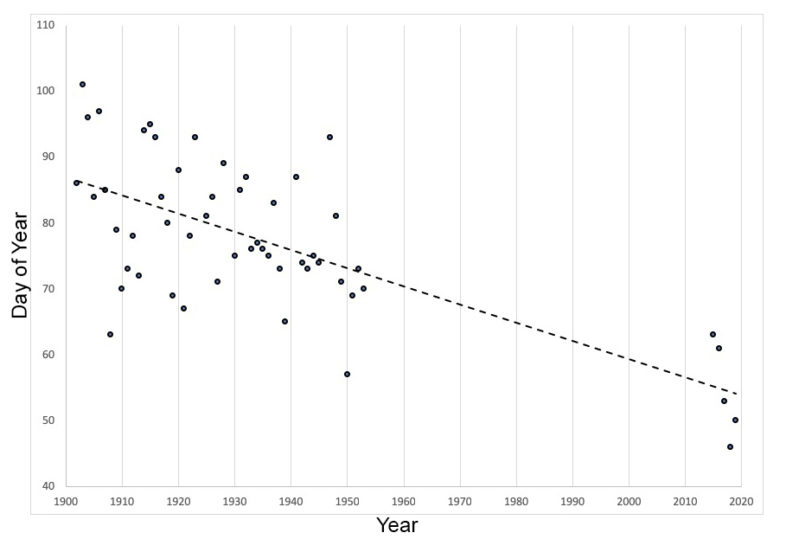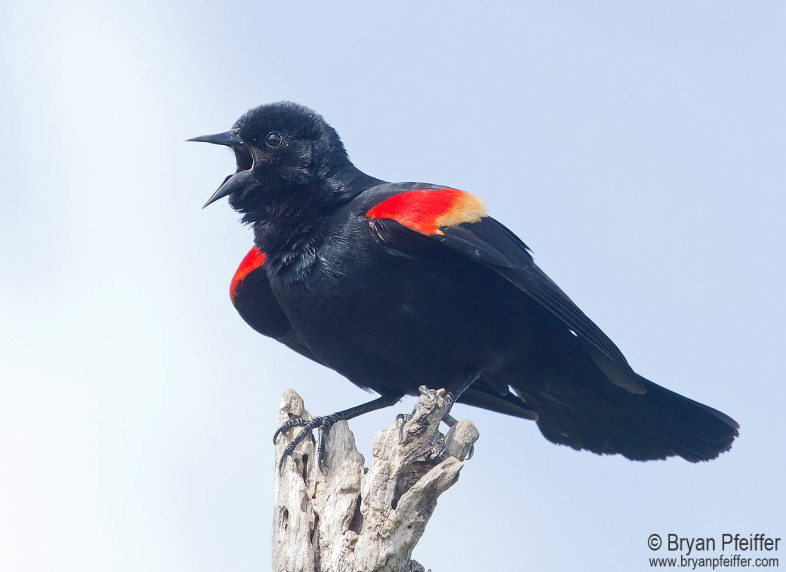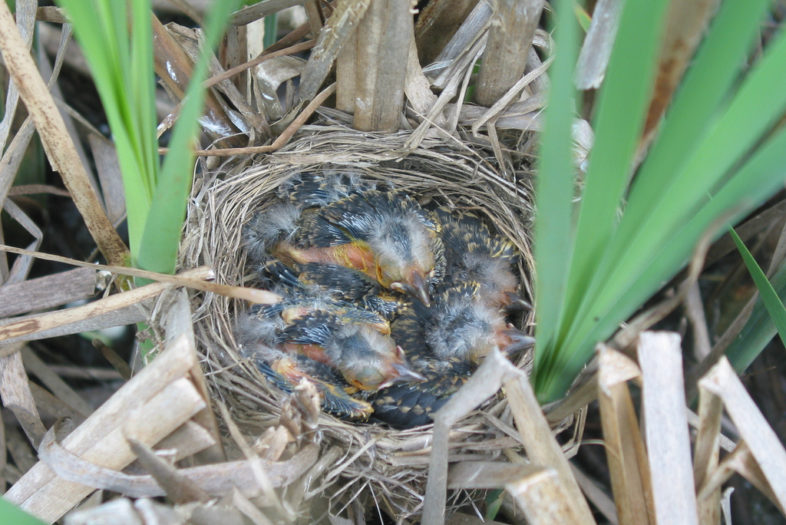There are many signs of spring that excite us here in northern New England. But perhaps the best sign from the bird world is the return of the Red-winged Blackbird. For several days each year the Red-winged Blackbird, a very common bird, becomes a rare crown jewel for bird watchers. The males always arrive ahead of females, vying with each other to defend the best territories so they can attract the best females. It’s a gamble. Early males risk encountering poor weather and scant food for the chance to beat other males to the best real estate.
Spring arrival dates over many years can be a great way for us to track and understand potential climatic effects on bird migration and populations. Phenology studies like these can alert us to slowly changing trends that we might not otherwise notice.
Getting her start in 1960, Kathleen Anderson recorded spring phenology on her 100-acre property just south of Boston for over 50 years. Everyday she recorded bird arrivals, plants flowering, butterflies emerging and frogs singing. She wasn’t systematic in her efforts, but year after year she paid attention on her walks or while sitting on the back porch and noted each observation in her diary.
Years later, scientists at Boston University were curious to know if a naturalist’s diary could be valuable for detecting potential changes in spring phenology. Since the first years of Anderson’s observations, the average spring temperature in that region rose 3.6° F. Did spring phenology change too?
Anderson’s diaries showed that many bird species arrived significantly earlier, like Wood Duck, which appeared 32 days earlier and Ruby-Throated Hummingbirds that came 18 days earlier. Overall, 22 of the 24 species they examined showed trends toward earlier spring activity, including Red-winged Blackbirds, which arrived about 2.5 days earlier.
Red-winged Blackbirds are also nesting earlier. An examination of nearly 5,000 nest records reported from bird watchers from across North America collected from 1956 to 2000 showed that females laid eggs 7.5 days earlier over the 50-year period.
The Vermont Phoenix Project
As part of the Vermont Atlas of Life, a few years ago we launched an ambitious project to retrieve historic bird sightings, some more than a century old and trapped in notebooks, on scraps of paper and in dusty file drawers. We named it the Vermont Phoenix Project for the mythical bird reborn from the ashes of its predecessor and for giving new life to historic bird records by moving them from paper to digital. With help from an army of volunteers and novel crowd-source technology, we’re adding these lost bird sightings to our vast, growing digital database at Vermont eBird so that they can be of use to birdwatchers, scientists, students and conservationists for generations.
Many answered our call for help. Volunteers helped us scan paper notes and joined our virtual expeditions. Together, we’ve digitized nearly 6,000 pages and 7,000 notecards of historic spring bird records from the Records of Vermont Birds (RVB). For 30 years, RVB was the most complete and authoritative source of bird sightings in the state, including first arrival dates for migrants, ever assembled on paper. Additionally, we’ve digitized more than a half-dozen journals from Vermont birdwatchers, some dating back to the early 1900s. Altogether, we’re well on the road to assembling over a century of spring bird phenology from across Vermont.
Red-winged Blackbird Arrival: A Century of Change
We’re far from done with capturing all the historic data, but the arrival of Red-winged Blackbirds this year has piqued my curiosity. Has their spring arrival changed over the years here too? I quickly examined a long-term dataset recently digitized by Ed Hack, volunteer and recipient of the 2011 Julie Nicholson Citizen Science Award.
In 1902 Dr. Lucretius H. Ross, a physician in Bennington and a president of the Vermont Bird Club, began noting the arrival times of birds he was seeing in the town. Each section of his notebook contained the arrival times and other observations of each bird species neatly typed or handwritten. On March 27, 1902 for Red-winged Blackbird he wrote, “first seen.” The next year it wasn’t until April 11th, the latest date he recorded over the 52 years he kept records. By the early 1950s his observations trended to earlier spring arrival dates, including his earliest record on February 26, 1950.
I wondered how that compared to modern observations by Bennington County birdwatchers reporting their first Red-winged Blackbird sightings to Vermont eBird. I visited the online database and found the first sighting for each of the last 5 years.
Birders spotted blackbirds much earlier, and in several years a few red-wings were even found during winter. Ross never noted or mentioned any winter records for Red-winged Blackbirds. In 1902, from the data we predict that the spring arrival date was day 86.5. By 2019, our estimate was day 54. Over a span of 117 years, Red-winged Blackbirds appear to be arriving 32.5 days earlier in Bennington County. Of course, this was just a quick examination of one person’s observations in the past to those of many now watching in modern times. Maybe we’re better at detecting them now with more people and better equipment. Or, maybe spring is arriving, on average, a lot earlier. We’ll be digging deeper into the data to learn more.

Earliest spring arrival dates for migrating Red-winged Blackbirds in Bennington, Vermont by Dr. L. H. Ross (1902-1953) and from Vermont eBird (2015-2019).
With the incredible bird record data being united from thousands of bird watchers from across the state on our Vermont eBird project each year, and the historic data we are adding to it, we’ll be uncovering many interesting patterns and following them each year far into the future. Join Vermont eBird, a project of the Vermont Atlas of Life, and help us shed more light on the changes in bird phenology and populations across the Green Mountain State and beyond.
Comments (5)
Pingbacks (1)
-
[…] McFarland, K. (2019, March 17). Red-winged Blackbirds Signal the Arrival of Spring. Retrieved February 26, 2020, from https://vtecostudies.org/blog/red-winged-blackbirds-signal-the-arrival-of-spring/ […]



I would think that tracking just the earliest arrival date could lead to anomalies due to individual birds that migrated abnormally early. Such data would be no more significant for phenology than it would be to include vagrants in determining a species’ range. It may be more useful to chart the date when they start arriving in “significant” numbers. The definition of “significant” would need to be determined mathematically, but I would imagine that each year reports start to “ramp up” to a point where it can be said that “yes, they have arrived.”
Sure. But this was just a quick look for this post. However, there isn’t a whole lot one can do when the oldest historic data tends to be just reporting the first arrival date, especially in this case with just one observer. That’s all we have to work with here. With a more robust dataset, we could use medians or even better, we could look at changes in the distributions of the data. With the way data is now collected by all of us in eBird, we will have plenty of data to work with in modern times, but historically, we often don’t have that luxury.But we’ll see what we end up with when we are done with the complete spring dataset. Great points!
When we first moved into our home in Barre in 1994, there were annually a large number of Red-winged blackbirds (as well as yellow winged) living in our large grass meadow.
We rarely see the birds anymore, even though we do not hay the meadow until mid-July (only once per year). We miss them.
Our questions are: Has the population of this bird dropped off? Why would they have stopped coming?
Your article suggests the Red-winged blackbird remain common in VT.
Horrific winter, tons of snow and very cold here in ND. We feed and water birds daily in our yard . Today Jan 14 2023, we were visited by a red wing blackbird ..I cannot understand what what he is thinking!!!!! There is not a square foot of bare ground anywhere , just miles and miles of deep snow and ice. Looks like Siberia here.
Spotted 4 Red Wing Blackbirds February 23rd 2024 in Port Clinton Ohio. Yes, another sign of an early spring 🌼 this year.